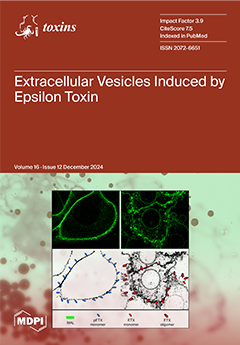Kojic acid is a secondary metabolite with strong chelating and antioxidant properties produced by
Aspergillus flavus and
A. oryzae. Although antioxidants and chelators are important virulence factors for plant pathogens, the ecological role of kojic acid remains unclear. We previously observed a
[...] Read more.
Kojic acid is a secondary metabolite with strong chelating and antioxidant properties produced by
Aspergillus flavus and
A. oryzae. Although antioxidants and chelators are important virulence factors for plant pathogens, the ecological role of kojic acid remains unclear. We previously observed a greater gene expression of antioxidants, especially kojic acid, by non-aflatoxigenic
A. flavus when co-cultured with aflatoxigenic
A. flavus. Aflatoxin production was also reduced. In this study, we investigated kojic acid production in 22
A. flavus isolates from Louisiana and compared them to four common
A. flavus strains in liquid medium and on corn kernels. Corn kernel infection was assessed by quantifying the maize
beta tubulin DNA content of the kernels using drop digital PCR (ddPCR). Maize
beta tubulin DNA content decreased with increased corn kernel infection. Greater kojic acid production by
A. flavus isolates coincided with greater levels of corn kernel infection. All isolates produced 60 and 700 times more kojic acid than aflatoxin and cyclopiazonic acid (a known virulence factor), respectively, which varied among sclerotial size categories.
A. flavus strains with small sclerotia, which were rarely isolated from corn, produced the least kojic acid and infected corn kernels the least, while medium and large sclerotia strains—mainly isolated from corn—produced the most kojic acid and were more infectious. Non-aflatoxigenic isolates from Louisiana produced the most kojic acid. These results suggest that kojic acid is a potential virulence factor and may increase the pathogenic success of medium and large sclerotia-producing
A. flavus, which could ultimately lead to more effective
A. flavus biocontrol strains. Further studies are required to determine the effects that kojic acid has on the redox environment during corn infection and how the altered redox environment decreases aflatoxin production.
Full article






